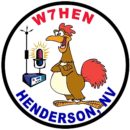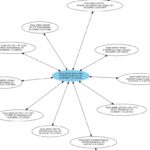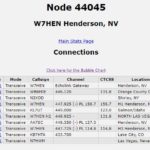
W7HEN Repeaters
HARC Operated Regional Repeater Network
Using local (Las Vegas metro area) repeaters owned, controlled, and/or operated by HARC under the W7HEN club callsign, our regular HARC club nets are held on networked “H” repeaters interconnected through AllStar. When linked together, these repeaters function as a single W7HEN repeater system.
The HARC AllStar hub: # 44045 is always on.
When programming your radio to use the W7HEN repeaters, make sure you have chosen the wide-band mode or set the deviation to 25 KHz, if not, you will be at least minus 3db (one-half) of the audio level. Talk CLOSE to your microphone – your nose should be touching the microphone when you are speaking.
Also, remember, Amateurs are secondary users of the 420-450 MHz band. To reduce interference to Government radio-location activities on the in the 420-450 MHz band (70cm), we in Southern Nevada below 37º latitude are limited to 50 watts (PEP) unless otherwise authorized. This is contained in 47 CFR §2.106 Footnote US270. This translates, roughly, into anywhere south of Mesquite which is 36.8º latitude.
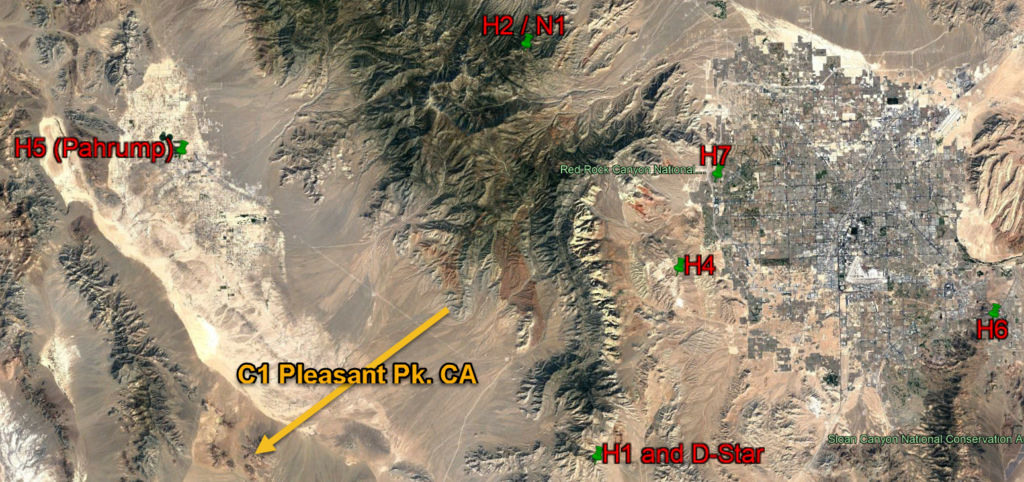
HARC Repeaters
Click on repeater designation below for more information
| Designation | Location | Frequency (MHz) | Offset (Frequency) (MHz) | Tone (Hz) | Transmitted Tone (Hz) | Elevation (feet) | Callsign | Ownership | Network Notes | Operational Status |
|---|---|---|---|---|---|---|---|---|---|---|
| H1 | Low Potosi | 447.925 | -5 (442.925) | 156.7 | 203.5 | 6200 | W7HEN | HARC | Networked | Active |
| H2 | Angel Peak | 449.850 | -5 (444.850) | 131.8 | 203.5 | 8881 | W7HEN | HARC | Networked | Active |
| N1 | Angel Peak Alternate input | 449.850 | -24.3 (425.550) | 156.7 | 203.5 | 8881 | W7HEN | HARC | Networked | Active |
| H3 | Henderson | 447.725 | -5 (442.725) | 114.8 | - | N8HC | Other | Sunday, only Allstar connections available | Active | |
| H4 | Blue Diamond Mountain | 446.475 | -5 (441.475) | 156.7 | 203.5 | 4820 | W7HEN | HARC | Standalone | Active |
| H5 | Pahrump | 449.925 | -5 (444.925) | 156.7 | - | 2599 | W7HEN | HARC | Networked | Active |
| H6 | Downtown Henderson | 445.525 | -5 (440.525) | 91.5 | - | 1981 | W7HEN | HARC | Networked | Active |
| H7 | Summerlin | 445.075 | -5 (440.075) | 123.0 | 203.5 | 3050 | W7HEN | HARC | Down for Maintenance | |
| B1 | Red Mtn. Boulder City | 446.500 | -5 (441.500) | 156.7 | 156.7 | 3630 | W7HEN | HARC | Networked | Active |
| C1 | Pleasants Peak, CA | 446.120 | -5 (441.120) | 131.8 | - | 3885 | W7HEN | HARC | Networked | Active |
| A1 | Sun City Anthem | 446.350 | -5 (441.350) | 127.3 | 91.5 | 3031 | AA7SC | Other | Sunday, only | Active |
| HARC <==> DMR | Summerlin | 445.775 | -5 (440.775) | Color Code 2 | Time Slot 2 | 3050 | KB6XN | TG: 3150894 | Linked on Brandmeister TG # is Static but may change in the future | Active |
| HARC <==> DMR | Las Vegas Valley | 445.825 | -5 (440.825) | Color Code 15 | Time Slot 2 | 2500 | KB6XN | TG: 3150894 | Linked on Brandmeister TG # is Static but may change in the future | Active |
| HARC <==> DMR | High Potosi | 449.525 | -5 (444.525) | Color Code 15 | Time Slot 2 | 6200 | KB6XN | TG: 3150894 | Linked on Brandmeister TG # is Static but may change in the future | Active |
| D-Star | Low Potosi | 446.975 | -5 (441.975) | - | 6200 | W7HEN | HARC | Standalone | Active | |
| W7HEN-3 Digipeater & iGate | Summerlin | 144.390 | - | - | - | 3050 | W7HEN-3 | Other | APRS |
Designation – How the Club refers to the individual repeater.
Location – Where the repeater is generally located.
Frequency – The frequency that should be programmed into your radio. This is the frequency on which the repeater transmits.
Offset (Frequency) – The amount of offset that should be applied to the frequency programmed into your radio. Most bands have standard offsets, and most modern radios are aware of the offset and will supply it automatically. The plus and minus sign indicates which direction the offset is from the receive frequency. Plus means add the offset to the receive frequency, minus means subtract the offset amount from the receive frequency. HARC repeaters use standard minus offsets of 5 MHz (for the 70cm band). The frequency listed is what your radio should show when you press the push-to-talk button.
Tone – This is a sub audible tone for which the repeater is listening. If the repeater hears the tone, your transmission will be passed to the transmitter to be repeated. If the repeater does not hear the tone, or hears an incorrect tone, your transmission will not be repeated.
Transmitted Tone – Some of our repeaters, while they are transmitting (and you are receiving), send a sub audible tone to your radio. Just as the repeater will not pass a signal on to be repeated/transmitted unless it hears the proper Tone (see above), your radio will not pass on a signal to be heard if your radio does not hear the specific Transmitted Tone. A radio may be operated with no receive tone, in which case, all transmissions on that frequency will be heard. Or, optionally, the Transmitted Tone from the repeater can be programmed into your radio so that your radio will only pass signals that contain that sub audible tone. The H1, H2, N1, H4, and H7 repeaters all transmit a tone of 203.5 Hz. Many Hams will only program the Transmitted Tone into their radios if there are other repeaters nearby interfering with their repeater, preferring, instead, to leave their radio “open” to all transmissions on that frequency.
Callsign – The FCC callsign assigned to the repeater
Ownership -The owner of the repeater; HARC for Club-owned repeaters, Other for affiliate repeaters.
Network Notes – Indicates repeater network participation;
Networked – On the network all of the time.
Sunday, only – Connected to the network for Sunday Night Net and Tek-Net, only.
Standalone – Operates in standalone mode – not connected to the network.
D-Star Repeater
Click here for a general Wikipedia overview of the D-Star protocol.
An Overview of How Repeaters Communicate
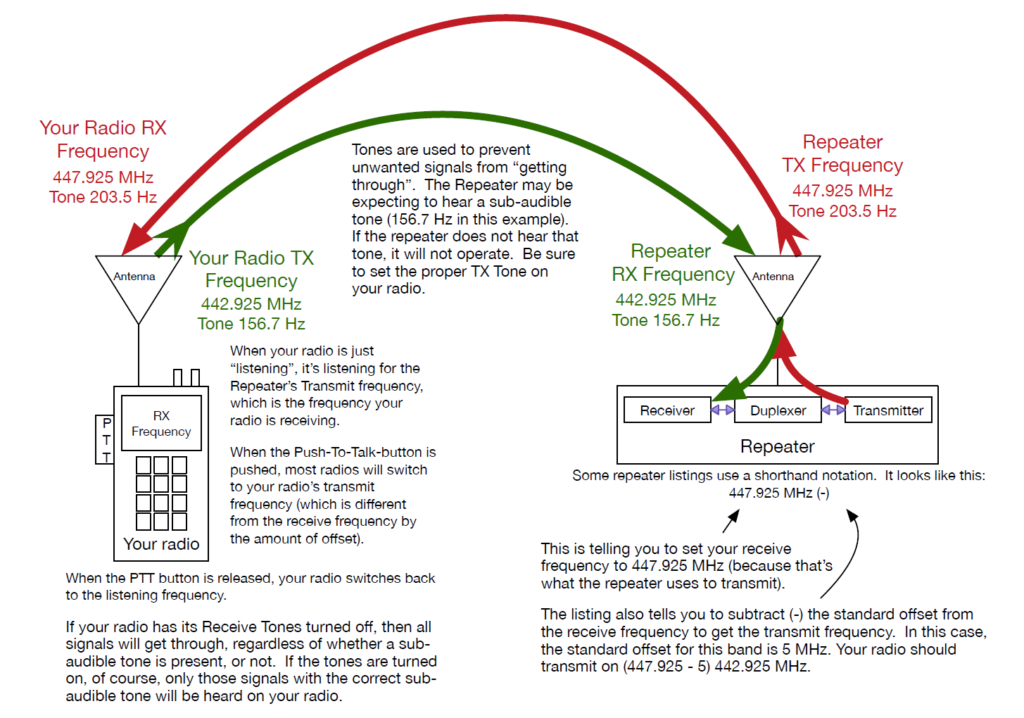
An explanation of some repeater-related terms.
Some radios have buttons and/or menus to help make operations easier.
Mon / Moni / Monitor
Remove any PL tone from the transmission to allow the user to monitor all transmissions on the frequency.
Your radio’s MON or MONI or MONITOR button removes any Receive Tone-Squelch when “ON”… This allows you to hear your RX frequency regardless of the PL. Typically RF-Squelch remains “ON”.
Talk Around
Transmitting and receiving on the repeater output frequency; using the repeater output frequency for SIMPLEX communication.
If your radio has this as an option, turning it ON will place your radio into a SIMPLEX Mode, where you are Transmitting and Receiving on the Repeater’s OUTPUT Frequency. You are “Talking Around” the Repeater for direct communication with the other station. – Good for Close-Range Com’s.
REV / REVERSE
Reverse the frequencies used to transmit and receive repeater transmissions.
This option will “FLIP” or REVERSE your TX/RX Frequencies. This option allows you to LISTEN on the Repeater’s INPUT Frequency (to hear close transmitters) while TRANSMITTING on the Repeater’s OUTPUT frequency.
Thanks to Dave (W3QQQ) for the explanations.
Current Connections Linked Through W7HEN – HARC Allstar Hub: # 44045
Click on the links below to display real-time information regarding the HARC Allstar network.
If you are still having questions about repeaters? Here’s a good place to keep learning:
'Repeaters 101' - A Beginners Guide to Repeaters
'Repeaters 101' - A Beginners Guide to Repeaters
